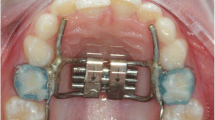Abstract
Background:
Rapid maxillary expansion (RME) is a therapeutic orthodontic option with a long history, and there are many reports in the literature reporting widely divergent results concerning the appliance efficacy and many different treatment protocols. We aimed to evaluate the treatment protocols and clinical experiences with RME via a national inquiry of orthodontists to identify the status quo of RME in clinical daily routine.
Method:
Within the framework of an anonymous questionnaire, 2003 orthodontists and members of the German Orthodontic Society (DGKFO) were asked to report on their clinical experiences with RME. The standardized questionnaire covered clinical indications, dentition period at the time of insertion, mode of activation, retention time, observed side effects, and the reasons for requiring surgical assistance.
Results:
The data from 487 questionnaires could be evaluated. The only indication for RME named by a large majority of responders was transversal maxillary deficiency. The average extent of the transversal deficiency amounted to 5.29 ± 2.25 mm (median 5 mm). Most orthodontists (87.7%) employed RME in the permanent dentition of adolescents; it was significantly less frequently applied in the primary dentition or adults. Answers regarding the mode of activation varied greatly.
The most frequent mode of activation was “1–2 activations a day” independent of the dentition period. 64.5% of the orthodontists reported buccal tipping of the anchorage teeth. No correlation was detected between mode of activation, time of insertion and observed side effects. 60% of the orthodontists reported a retention period of between 3 and 6 months (median 4.5 months). With an average age of 19.28 years, 79.3% assessed chronological age as a limiting factor for conventional RME. It was not possible to identify a homogeneous diagnostic procedure for the indication of surgical assistance.
Conclusions:
Although RME has a long clinical history, no standardized treatment protocols exist. Randomized clinical trials are necessary to make clear-cut clinical recommendations on the use of RME, as required by the tenets of evidence-based medicine and quality assurance.
Zusammenfassung
Hintergrund:
Obwohl die Gaumennahterweiterung (GNE) eine der ältesten Behandlungsmethoden in der Kieferorthopädie darstellt, liegen in der Fachliteratur unterschiedliche Aussagen zur Wirkungsspezifität und verschiedene Therapieprotokolle vor. Mittels einer nationalen Umfrage unter Kieferorthopäden sollen angewandte Therapieverfahren und klinische Erfahrungen im täglichen Umgang mit der GNE evaluiert werden, um so einen Status quo der Behandlungsmodalität „GNE“ im klinischen Alltag zu erhalten.
Methodik:
Es wurden 2003 Fachzahnärzte für Kieferorthopädie, die gleichzeitig Mitglieder der DGKFO sind, gebeten, im Rahmen einer anonymen Befragung ihre klinische Erfahrung mit der GNE zu dokumentieren. Im standardisierten Fragebogen wurden mögliche klinische Indikationsstellungen, Dentitionsstatus zum Zeitpunkt der Insertion, Art der Aktivierung, Retentionsphase, klinisch beobachtete Nebenwirkungen und Indikationsstellung einer chirurgisch unterstützten GNE thematisiert.
Ergebnisse:
Es konnten 487 Bögen ausgewertet werden. Einzig eine transversale Unterentwicklung der Maxilla wurde als Indikationsstellung einer GNE mehrheitlich anerkannt. Die hierfür mindestens vorliegende transversale Unterentwicklung wurde mit durchschnittlich 5,29 ± 2,25 mm (Median 5 mm) angegeben. Die meisten Kieferorthopäden (87,7%) setzten eine GNE im permanenten Gebiss bei Jugendlichen ein. Deutlich vermindert war der Einsatz der GNE im Milchgebiss und bei Erwachsenen.
Die Angaben zum Aktivierungsmodus variierten sehr stark. „1–2 Aktivierungen pro Tag“ stellte zu jedem Dentitionszeitpunkt den am häufigsten angegebenen Aktivierungsmodus dar. Eine Bukkalkippung der Verankerungszähne wurde als unerwünschte Nebenwirkung von 64,5% der Befragten beobachtet. Zwischen dem Ausmaß der Aktivierung sowie dem Zeitpunkt der Insertion konnte keine Korrelation zu den beobachteten Nebenwirkungen ermittelt werden. Bei 60% der Kieferorthopäden betrug die Retentionszeit zwischen 3 und 6 Monaten (Median 4,5 Monate). 79,3% bewerteten das chronologische Alter mit einer durchschnittlichen Angabe von 19,28 Jahren als einen limitierenden Faktor für eine konservative GNE. Ein einheitliches diagnostisches Vorgehen für die Entscheidung einer chirurgisch unterstützten GNE konnte nicht ermittelt werden.
Schlussfolgerungen:
Obwohl die GNE über eine lange klinische Geschichte verfügt, liegt kein einheitliches Behandlungsprotokoll vor. Randomisierte klinische Studien müssen folgen, um im Sinne der evidenzbasierten Medizin und der Qualitätssicherung eindeutige klinische Empfehlungen zur Anwendung der GNE geben zu können.
Similar content being viewed by others
Author information
Authors and Affiliations
Corresponding author
Rights and permissions
About this article
Cite this article
Korbmacher, H., Huck, L., Merkle, T. et al. Clinical Profile of Rapid Maxillary Expansion—Outcome of a National Inquiry. J Orofac Orthop 66, 455–468 (2005). https://doi.org/10.1007/s00056-005-0440-5
Received:
Accepted:
Issue Date:
DOI: https://doi.org/10.1007/s00056-005-0440-5




